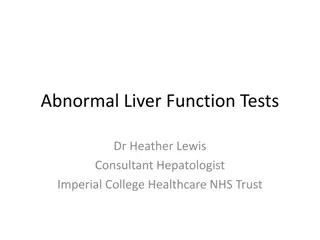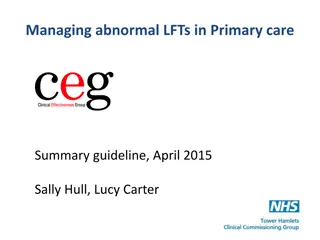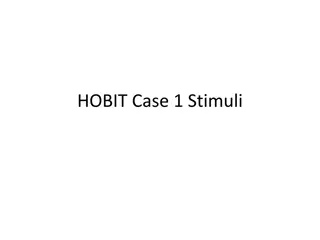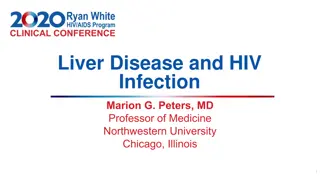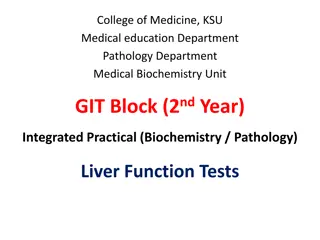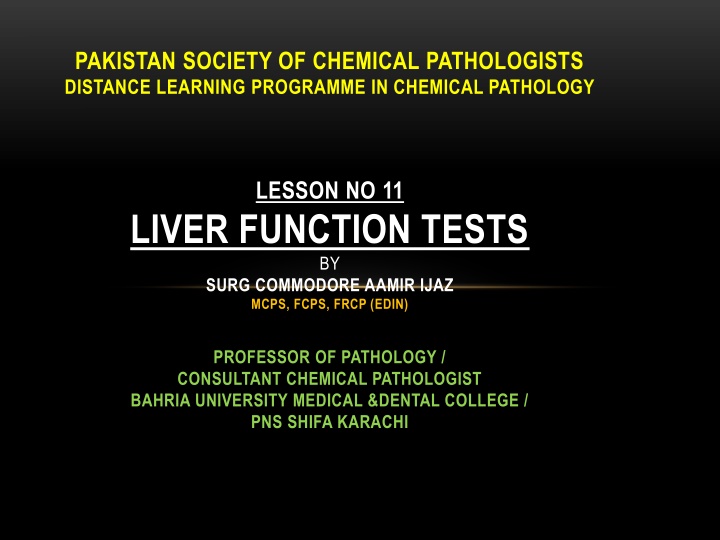
Chemical Pathology Lesson: Liver Function Tests and Diseases Overview
Explore a comprehensive lesson on liver function tests and various liver diseases presented by Surg. Commodore Aamir Ijaz. Learn about different liver conditions, diagnostic tests, and their implications, including EMQs for practice.
Download Presentation

Please find below an Image/Link to download the presentation.
The content on the website is provided AS IS for your information and personal use only. It may not be sold, licensed, or shared on other websites without obtaining consent from the author. If you encounter any issues during the download, it is possible that the publisher has removed the file from their server.
You are allowed to download the files provided on this website for personal or commercial use, subject to the condition that they are used lawfully. All files are the property of their respective owners.
The content on the website is provided AS IS for your information and personal use only. It may not be sold, licensed, or shared on other websites without obtaining consent from the author.
E N D
Presentation Transcript
PAKISTAN SOCIETY OF CHEMICAL PATHOLOGISTS DISTANCE LEARNING PROGRAMME IN CHEMICAL PATHOLOGY LESSON NO 11 LIVER FUNCTION TESTS BY SURG COMMODORE AAMIR IJAZ MCPS, FCPS, FRCP (EDIN) PROFESSOR OF PATHOLOGY / CONSULTANT CHEMICAL PATHOLOGIST BAHRIA UNIVERSITY MEDICAL &DENTAL COLLEGE / PNS SHIFA KARACHI
Match the answers (Extended Matching Questions) Acute viral hepatitis a. Dubin-Johnson syndrome: i. b. Alcoholic liver disease j. Gilbert Syndrome c. Biliary atresia k. Haemochromatosis d. Breast milk jaundice l. Hemolytic Disease of the newborn e. Chronic Hepatitis C f. Congenital Hyperbilirubinaemia m. Obstructive Liver Disease n. Rotar Syndrome g. Crigler-Najjar Type I o. Wilson s disease h. Crigler-Najjar Type II
Q. 1: A 27 years old soldier complained of generalized symptoms for the last 3 days. His Serum ALT was more than 2500 U/L on two occasions but he did not have jaundice. What is the most probable diagnosis in this patient? a. Acute viral hepatitis
Hepatic Transaminases ALT is mainly a cytoplasmic enzyme AST has two fractions : Cytoplasmic AST Organellar AST In Acute Hepatitis, only cell membrane is damaged while organelles remain intact So in Acute Hepatitis ALT is markedly increased as compared to AST
Hepatic Transaminases (Cont) ALT may be the first or only liver marker to rise In Chronic Hepatitis AST is a better marker AST lacks specificity So for diagnosis and monitoring of Chronic Hepatitis (Hep B and C), ALT can be used.
Neonatal (Physiological) Jaundice Full Term infants jaundice lasts for about 10 days with a rapid rise of serum bilirubin up to 204 mol/L (12 mg/dL). Preterm infants jaundice lasts for about two weeks, with a rapid rise of serum bilirubin up to 255 mol/L (15 mg/dL). Phase two bilirubin levels decline to about 34 mol/L (2 mg/dL) for two weeks, eventually mimicking adult values. Preterm infants - phase two can last more than one month.
Pathological Neonatal Jaundice Any of the following features characterizes pathological jaundice: Clinical jaundice appearing in the first 24 hours Jaundice lasting more than 14 days of life. Increases in the level of total bilirubin by more than 8.5 mol/L (0.5 mg/dL) per hour or (85 mol/L) 5 mg/dL per 24 hours. Total bilirubin more than 331 mol/L (19.5 mg/dL) Direct bilirubin more than 34 mol/L (2.0 mg/dL).
Causes of Pathological Neonatal Unconjugated Hyperbilirubinemia Hemolytic Disease of the Newborn: The most common cause of pathologic indirect hyperbilirubinemia is increased bilirubin production due to hemolytic disease processes Decreased Clearance: Congental condition like Crigler- Najjar syndrome and Gilbert Syndrome Breast Milk Jaundice: A very common cause Other Causes e.g. GDM
Q. 2: A 22 years year old medical student was upset to find that her sclera sometimes look yellow specially when she is fasting and after taking Panadol for trivial problems. She discussed the problem with her clinical teacher who got her LFTs. On seeing the report he assured her that this is due to a benign liver disease which is very common. Her LFTs were: Conjugated Bilirubin: 5 mol/L (<4) Unconjugated Bilirubin: 30 mol/L (<14) ALT : 22 U/L (< 42) ALP : 145 U/L (85- 306) Most is the most probable diagnosis in this patient? j. Gilbert Syndrome
Congenital Casuses of Hyperbilirubinaemia Unconjugated Bilirubinaemia Gilbert syndrome: Crigler-Najjar Conjugated Bilirubinaemia Dubin-johnson syndrome: Rotar Syndrome
Gilbert's Syndrome The most common inherited disorder of bilirubin glucuronidation (9-10% of the adult population) Also called "constitutional hepatic dysfunction" and "familial nonhemolytic jaundice" Enzyme Defect: Uridinediphosphoglucuronate glucuronosyltransferases (UGTs) which is a family of enzymes that mediate glucuronidation of various endogenous and exogenous compounds Genetic Defect: The mutation is in the promoter region, upstream to exon 1 of the gene encoding bilirubin-UGT
Q. 3: A 10 days old baby has following LFT : Conjugated Bilirubin : 34 mol/L (<4) Unconjugated Bilirubin: 378 mol/L (<14) ALT : 54 U/L (< 42) ALP : 745 U/L (85- 730) Albumin : 49 g /L (35-50) What is the most probable diagnosis in this patient? l. Haemolytic Disease of the Newborn (HDN)
Haemolytic Disease of the Newborn (HDN) HDN is a condition in which the red cells of the fetus or newborn are destroyed by maternally-derived alloantibodies. These antibodies arise in the mother as the direct result of a blood group incompatibility between the mother and fetus, For example when Rh(D) negative mother carries an Rh(D) positive fetus
Incidence of HDN In developed world very high incidence has been reduced due to immunization of Anti D. In Pakistan, exact incidence is not known. However, in a local study, ABO incompatibility was known to be the major cause of HDN (71%)
Crigler-Najjar Syndrome (CNS) Type I Very rare; only about 100 cases have been reported. Autosomal recessive inheritance. Severe neonatal jaundice with Bilirubin Induced Neurological Damage (BIND) and death within 24 months Uncojugated bilirubin is high at 342-770 mol/L (20-45 mg/dL) with almost absent Conjugated bilirubin Phenobarbital has no effect on bilirubin levels. Absence of bilirubin glucuronides in bile.
CNS Type II More common than type I but still very rare. Predominantly autosomal recessive inheritance. Unconujgated bilirubin 103-342 mol/L (6-20 mg/dL). Mild persistent jaundice in childhood, without brain damage. Phenobarbital reduces bilirubin levels by ~30%. Bilirubin glucuronides present in bile.
Q. 4: A 66 years year old male has following LFT : Conjugated Bilirubin : 334 mol/L (<4) Unconjugated Bilirubin : 34 mol/L (<14) ALT : 62 U/L (< 42) ALP : 1045 U/L (85- 306) Albumin : 49 g /L (35-50) m. Obstructive Liver Disease
Q. 5: A 25 days baby presents with jaundice and failure to thrive. Some of his live tests show: Conjugated Bilirubin : 35 mol/L (<4) Unconjugated Bilirubin : 63 mol/L (<14) Gamma-glutamyl transpeptidase*: 1334 U/L (<385) * also called Gamma-glutamyl transferase c. Biliary atresia
Conjugated Hyperbilirubinaemia Defined as: Conjugated bilirubin > 17 mol/L (1 mg/dl) - when total Bilirubin is < 85 mol/L (5 mg/dl) Or Conjugated bilirubin > 20 % - When total Bilirubin is > 85 mol/L (5 mg/dl)
Biliary Atresia It is a progressive, idiopathic, fibro-obliterative disease of the extrahepatic biliary tree that presents with biliary obstruction exclusively in the neonatal period It is the most common cause of neonatal jaundice for which surgery is indicated and the most common indication for liver transplantation in children.
Biochemical Findings in Biliary Atresia Elevations in bilirubin (conjugated bilirubin 34 mol/L (2 mg/dL) Mild or moderate elevations in ALT or AST A disproportionately increased Gamma Glutammyl Transferase
Q. 6: A new-born developed jaundice at four days of life. His serial bilirubin reports showed following results: At 4th day of Life: Unconjugated Bilirubin: 72 mol/L At 14th day of Life: Unconjugated Bilirubin: 186 mol/L At 10th week of life Unconjugated Bilirubin: 10 mol/L d. Breast milk jaundice
Breast Milk Jaundice (BMJ) It is defined as the persistence of physiologic jaundice beyond the first week of age. Typically starts after the first three to five days of life Peaks within two weeks after birth, Progressively declines to normal levels over 3 to 12 weeks BMJ is a benign condition, needs to be distinguished from breastfeeding failure jaundice that occurs within the first seven days of life, which is caused by decrease intake resulting in excessive weight and fluid loss.
BMJ (cont) A factor in human milk that promotes an increase in intestinal absorption of bilirubin may be responsible. Beta-glucuronidase is a candidate substance as it deconjugates intestinal bilirubin, increasing its ability to be absorbed (i.e, increasing enterohepatic circulation). Approximately 20 to 40 percent of women have high levels of beta-glucuronidase in their breast milk. Blocking the deconjugation of bilirubin through beta- glucuronidase inhibition may provide a mechanism to reduce intestinal absorption of bilirubin in breastfed infants
Q. 7: Which of the following hepatic enzymes has the highest concentration in the cytoplasm of the liver cells: a. 5 Nucleotidase b. Alkaline Phosphatase c. ALT d. AST e. Gamma Glutamyl Transferase c. ALT
Q. 8: Which of the following enzymes is a Membrane Bound Enzyme : a. 5 Nucleotidase b. Cholinesterase c. Glutamyl Dehydrogenase d. Glutathione S-Transferase e. Isocitrate dehydrogenase a. 5 Nucleotidase
Membrane Bound Hepatic Enzymes Membrane bound hepatic enzymes are: Alkaline Phosphatase (ALP) Gamma Glutamyl Transferase (Gamma GT) 5-prime Nucleotidase Increased in Cholestasis Bound with cell membranes of endothelial cells of bile canaliculli Obstruction and stasis cause digestion of fat content of cell membranes.
Q. 9: Which of the following pattern is most commonly found in Alcoholic Hepatitis? a. Raised Alkaline Phosphatase / Gamma GT ratio b. Raised AST / ALT ratio c. Raised Bilirubin / Alkaline Phosphatase ratio d. Raised Bilirubin / ALT ratio e. Reduced AST / ALT ratio b. Raised AST / ALT ratio
Q. 10: Serum Bilirubin estimation is one of the most common investigations carried out in any laboratory. Please answer following questions regarding this test: a. Name various HPLC based fractions of Bilirubin. How will you classify these fractions on the basis of Diazo reaction? b. Name various methods used for estimation of bilirubin including a non-invasive method. c. Regarding Unconjugated Bilirubinaemia please answer following questions: i. From which ward or department of any hospital most samples with unconjugated bilirubinaemia are received? ii. What are common problems encountered in this estimation? iii. What remedial measure(s) you will suggest to solve these problems?
Suggested Answer to Q.10 a Name various HPLC based fractions of Bilirubin. How will you classify these fractions on the basis of Diazo reaction?
HPLC Based Fractions of Bilirubin Alpha ( -bilirubin) Beta bilirubin ( -bilirubin) Gamma ( -bilirubin) (delta) -bilirubin
HPLC Based Fractions of Bilirubin Alpha ( -bilirubin) Beta bilirubin ( -bilirubin) Gamma ( -bilirubin) (delta) -bilirubin
Classification of Bilirubin based on Diazo Reaction Direct Bilirubin: Beta (monocojugated) Gamma (diconjugated) Delta bilirubin Indirect Bilirubin Alpha (unconjugated) bilirubin
Suggested Answer to Q.10 b Name various methods used for estimation of bilirubin including a non- invasive method. .
Methods of Bilirubin Estimation Diazo method DPD HPLC Capillary electrophoresis methods Enzymatic methods Direct spectrophotometry Transcutaneous measurement of bilirubin (non invasive)
Suggested Answer to Q.10 c Regarding Unconjugated Bilirubinaemia please answer following questions: i. From which ward or department of any hospital most samples with unconjugated bilirubinaemia are received? Neonatal Intensive Care Unit (Paeds) .
Suggested Answer to Q.10 c Regarding Unconjugated Bilirubinaemia please answer following questions: ii. What are common problems encountered in this estimation? .
Common Problems in Neonatal Bilirubin Estimation Haemolysed samples as HDN is the commonest cause Effect of Sunlight: Degradation of Bilirubin Phototherapy: May lead to variation in bilirubin concentration Estimation with Samples from Adults using the same standard or using same factor. Small sample volume hindering repeating the assay All these problems lead to frequent inter-departmental conflicts between Path and Paed Deptt.
Suggested Answer to Q.10 c Regarding Unconjugated Bilirubinaemia please answer following questions: iii. What remedial measure(s) you will suggest to solve these problems? .
Remedial Measures for Neonatal Bilirubin Estimation Haemolysed samples Since HDN is the commonest cause of Neonatal Bilirubinaemia, the test has to done on these samples with haemolysis and one cannot reject these samples. Technical measures can be adopted e.g.: Sample blanking Hb Blanking Dilution of samples.
Remedial Measures for Neonatal Bilirubin Estimation Neonatal Bilirubin as a Separate test: It is essential that a separate test should be created in your test directory for neonatal samples by the name of Neonatal Bilirubin The Analytical Measurement Range for this test should be established with much higher upper limit e.g. at 450 mol/L . The QC used for this test should also at a higher levels e.g. 150 mol/L and 350 mol/L. The reference range used for this test should be determined by estimating bilirubin in an appropriate number (n) of disease free neonates of your population.
Q. 11: Isolated rise of ALT is a very common and often puzzling problem a Chemical Pathologist has to face. Suppose you are working as a Consultant Chemical Pathologist in a tertiary care hospital lab. In a weekly meeting your PG Resident has presented following three patients with isolated rise of ALT to seek your opinion. Please note she has collected clinical information about these patients just from the request forms and has not seen these patients:
Suggested Answer to Q.11 a Patient No 1: A 44 years known patient of Hepatitic C (Recent PCR negative for both HCV and HBV) and Diabetes Mellitus has following LFTs: Total Bilirubin : 7 mol/L (<17) ALT : 94 U/L (< 42) ALP : 145 U/L (85- 307) Albumin : 46 g /L (35-50) a. Non-Alcoholic Fatty Liver Disease b. Lipid Profile, Glucose (F) and USG (with some interpretation points)
Suggested Answer to Q.11 b Patient No 2: A 39 years patient has severe fatigability, impotence, and hepatomegaly. He has following LFTs: Total Bilirubin : 14 mol/L (<17) ALT : 294 U/L (< 42) ALP : 345 U/L (85- 307) Albumin : 36 g /L (35-50) a. Haemochromatosis b. Ferritin, Transferrin Saturation and HFE gene studies (with some interpretation points)
Suggested Answer to Q.11 c Patient No 3: A 58 years known patient of Coronary Artery Disease patient has following LFTs: Total Bilirubin : 09 mol/L (<17) ALT : 87 U/L (< 42) ALP : 233 U/L (85- 307) Albumin : 47 g /L (35-50) a. Hepatotoxic effect of statins and NAFLD b. Lipid Profile to titrate the dose, CK to see the myopathic effects and tests for NAFLD (with some interpretation points)

